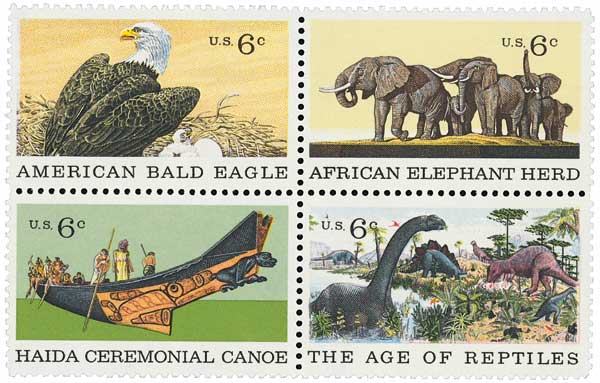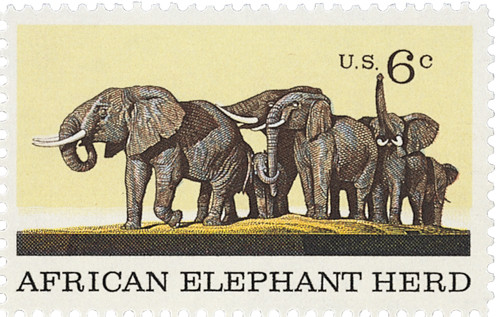
# 1387 - 1970 6c Natural History: American Bald Eagle
Natural History
The American Museum Of Natural History Is Established
The museum was largely the dream of naturalist Dr. Albert S. Bickmore. For several years, Bickmore lobbied extensively for the creation of a natural history museum in New York.
In 1869, Bickmore gained the support of several wealthy sponsors, including Theodore Roosevelt, Sr. (father of future President Theodore Roosevelt), J.P. Morgan, and Charles A. Dana. With their strong support, Bickmore gained New York Governor John Thompson Hoffman’s approval. The governor signed a bill officially establishing the museum on April 6, 1869. That same year, John David Wolfe is made the museum’s first president.
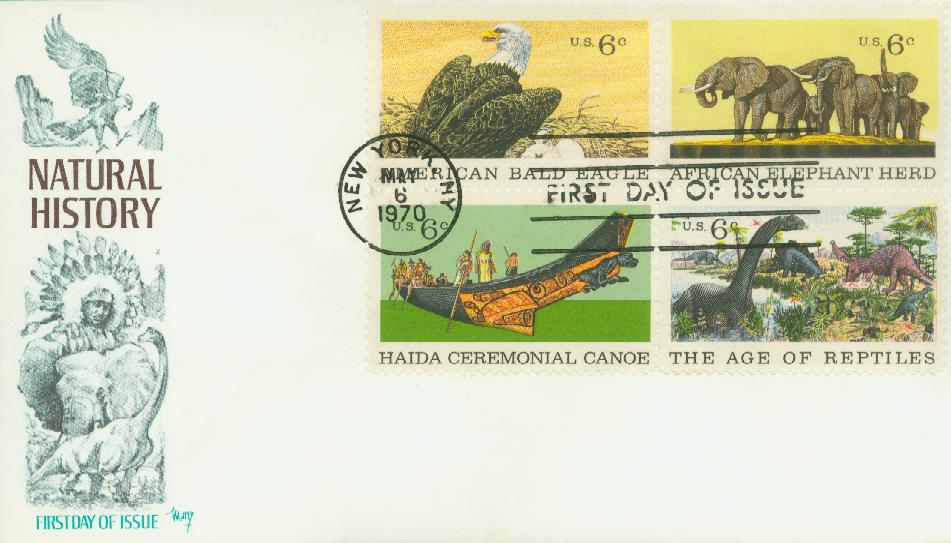
In 1871, exhibits from the museum go on display for the first time at the Central Park Arsenal. By the following year, the museum already began to outgrow its space at the Arsenal, so its leaders petitioned for a larger space – Manhattan Square. The new property encompassed an entire block across the street from Central Park. While the approved funding only covered a small building, the project’s architects planned a massive museum covering the entire site.
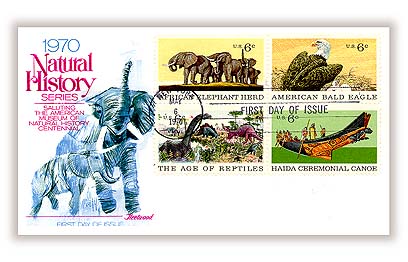
In 1874, President Ulysses S. Grant laid the cornerstone for the new building at 77th Street. Three years later, President Rutherford B. Hayes presided over the opening ceremony of the first building.
Beginning in the 1880s, the museum launched a series of expeditions to the North Pole, Siberia, Outer Mongolia, Gobi, and the Congo. These expeditions helped greatly expand their collections to represent every continent on Earth.
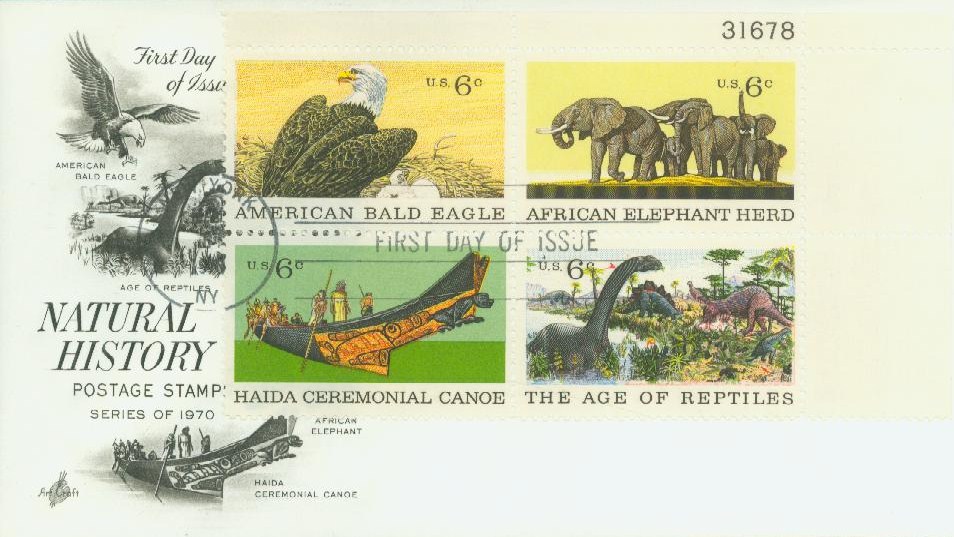
Throughout the 20th century, the museum expanded significantly with exhibits featuring a wide range of topics. These include Halls dedicated to the Northwest Coast, African Mammals, South Asiatic Mammals, Ocean Life, North American Mammals (which is home to some of the finest habitat dioramas in the world), African mammals, American Forests, North American Small Mammals, Primates, Eastern Woodlands Indians, Plains Indians, African Peoples, Mexico and Central America, Pacific Peoples, Minerals, Reptiles and Amphibians, Asian People, Meteorites, South American Peoples, Human Biology and Evolution, Primitive Mammals, Advanced Mammals, Saurischian Dinosaurs, Ornithischian Dinosaurs, Vertebrate Origins, Biodiversity, Planet Earth, and Human Origins.
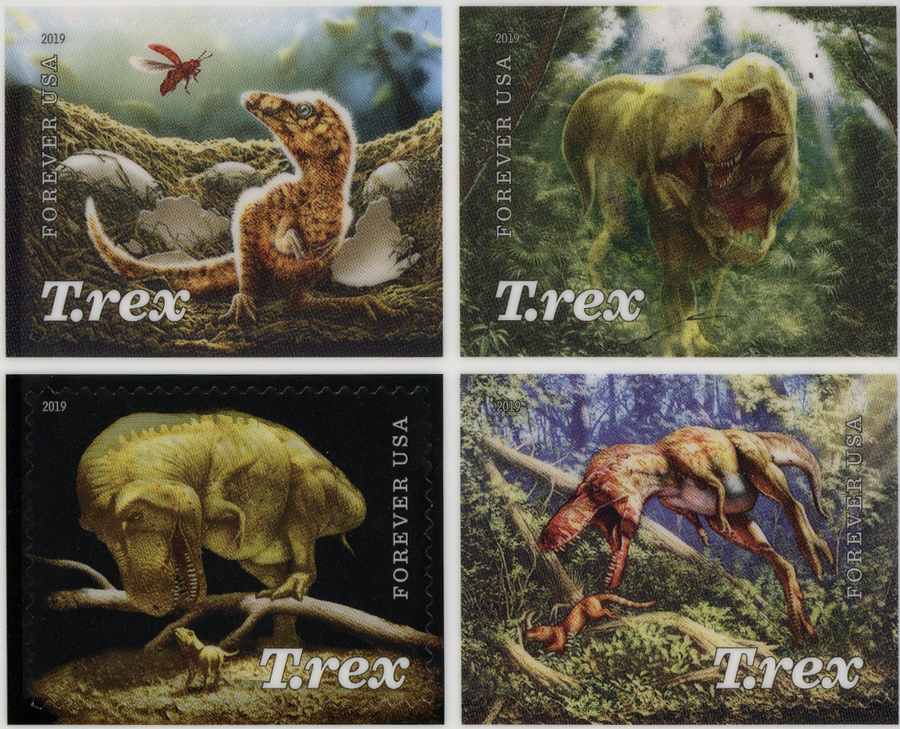
The museum also opened its famed Hayden Planetarium in 1935. And in 1991, the museum installed a five-story tall Barosaurus cast, which was the world’s highest freestanding dinosaur display. In 2006 the movie A Night at the Museum was set in the museum. This inspired them to start holding Night at the Museum Sleepovers for children and their families.
Today the museum is one of the largest natural history museums in the world. It consists of 26 buildings and 45 permanent exhibition halls containing over 34 million items. The museum has one mission statement: “To discover, interpret, and disseminate – through scientific research and education – knowledge about human cultures, the natural world, and the universe.”
Natural History
The American Museum Of Natural History Is Established
The museum was largely the dream of naturalist Dr. Albert S. Bickmore. For several years, Bickmore lobbied extensively for the creation of a natural history museum in New York.
In 1869, Bickmore gained the support of several wealthy sponsors, including Theodore Roosevelt, Sr. (father of future President Theodore Roosevelt), J.P. Morgan, and Charles A. Dana. With their strong support, Bickmore gained New York Governor John Thompson Hoffman’s approval. The governor signed a bill officially establishing the museum on April 6, 1869. That same year, John David Wolfe is made the museum’s first president.

In 1871, exhibits from the museum go on display for the first time at the Central Park Arsenal. By the following year, the museum already began to outgrow its space at the Arsenal, so its leaders petitioned for a larger space – Manhattan Square. The new property encompassed an entire block across the street from Central Park. While the approved funding only covered a small building, the project’s architects planned a massive museum covering the entire site.

In 1874, President Ulysses S. Grant laid the cornerstone for the new building at 77th Street. Three years later, President Rutherford B. Hayes presided over the opening ceremony of the first building.
Beginning in the 1880s, the museum launched a series of expeditions to the North Pole, Siberia, Outer Mongolia, Gobi, and the Congo. These expeditions helped greatly expand their collections to represent every continent on Earth.

Throughout the 20th century, the museum expanded significantly with exhibits featuring a wide range of topics. These include Halls dedicated to the Northwest Coast, African Mammals, South Asiatic Mammals, Ocean Life, North American Mammals (which is home to some of the finest habitat dioramas in the world), African mammals, American Forests, North American Small Mammals, Primates, Eastern Woodlands Indians, Plains Indians, African Peoples, Mexico and Central America, Pacific Peoples, Minerals, Reptiles and Amphibians, Asian People, Meteorites, South American Peoples, Human Biology and Evolution, Primitive Mammals, Advanced Mammals, Saurischian Dinosaurs, Ornithischian Dinosaurs, Vertebrate Origins, Biodiversity, Planet Earth, and Human Origins.

The museum also opened its famed Hayden Planetarium in 1935. And in 1991, the museum installed a five-story tall Barosaurus cast, which was the world’s highest freestanding dinosaur display. In 2006 the movie A Night at the Museum was set in the museum. This inspired them to start holding Night at the Museum Sleepovers for children and their families.
Today the museum is one of the largest natural history museums in the world. It consists of 26 buildings and 45 permanent exhibition halls containing over 34 million items. The museum has one mission statement: “To discover, interpret, and disseminate – through scientific research and education – knowledge about human cultures, the natural world, and the universe.”







